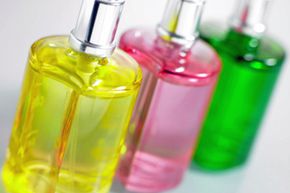As part of a grooming regimen, fragrance can perform a number of functions. It can cover up other smells, like the smell of fresh sweat. It can also mask the smells of chemical additives in shampoos, soaps, topical medications, cosmetics, moisturizers, lotions and detergents. It can stimulate pleasant memories: Think of the smell of pumpkin spice, or cinnamon or vanilla. They may remind you of the holidays, or your grandmother's house or your favorite bakery. Pleasant food smells could be mildly erotic in the right circumstances. Scents can also create powerful associations you can evoke at will. If you always wear a rose or gardenia fragrance, then people who interact with you will come to associate roses and gardenias with your presence. When they smell that fragrance in the future, there's a good chance they'll think of you.
If you're a new bride, wearing a special perfume on your wedding day will link that fragrance to the event. Set the perfume aside for a year and then use it again on your anniversary and you'll be transported back to your wedding day and remember the anticipation and excitement you felt then. Scent conjures visceral, dynamic and compelling memories. It has that kind of power.
Advertisement
It's no wonder fragrance is used in everything from dishwashing liquid to nail polish remover. And it's the proliferation of fragrance in our modern culture that can cause problems. Not all fragrances are compatible. We don't mean your perfume will smell nasty around cabbage or garlic, either. You can actually take two perfectly pleasant fragrances, put them together and get an unpleasant result. If you only used perfume, or deodorant or shampoo, it wouldn't be much of a problem. You probably use lots of fragrances jumbled together, though. They mix and combine, creating a blended smell none of the individual personal care product manufacturers intended.
On the next page, let's take a look at some ways you can make multiple fragrances work with you instead of against you. It's the science of fragrance in action.
Advertisement
